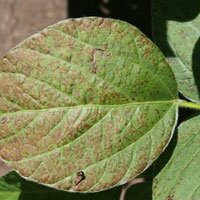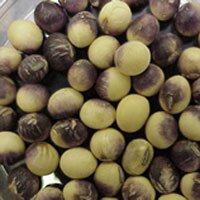
-
Soybean Diseases
- Asian Rust
- Anthracnose
- Bacterial Blight
- Bacterial Pustule
- Bean Pod Mottle Virus
- Brown Stem Rot
- Cercospora Leaf Blight
- Charcoal Rot
- Downy Mildew
- Frogeye Leaf Spot
- Green Stem Syndrome
- Iron Deficiency Chlorosis
- Phytophthora Root & Stem Rot
- Powdery Mildew
- Rhizoctonia
- Seedling Diseases
- Septoria (Brown Spot)
- SCN (Soybean Cyst Nematode)
- Soybean Mosaic Virus
- Stem Canker
- Sudden Death Syndrome
- Viruses
- White Mold
- Soybean Pests
- Diagnostic Help
- Field Trials
- Soybean Library
| Disease: Cercospora Leaf Spot |
Your Soybean Checkoff.
Delivering Results.
Illinois
Indiana
Iowa
Kansas
Michigan
Minnesota
Missouri
Nebraska
North Dakota
Ohio
South Dakota
Wisconsin
Cercospora Leaf Blight
 |
| A late-season bronzing of the leaves is a symptom of infection by the Cercospora leaf blight pathogen. Photo credit: Paul Esker, University of Wisconsin |
 |
| Cercospora can also infect seed, causing a purple stain. Photo credit: L. Giesler, University of Nebraska |
Cercospora leaf blight of soybean is caused by the fungus Cercospora kukuchii, a close relative of the frogeye leaf spot pathogen, Cercospora sojina.
This late-season leaf and seed disease shows up in during pod-filling stages. It is relatively easy to identify by a light purple to bronze discoloration that resembles a sunburn on the uppermost leaves. The coloration deepens and takes on a leathery appearance as the plants approach maturity.
Seeds can also be infected, resulting in a seed disease called purple seed stain.
Cercospora leaf spot is becoming more common in the North Central region.
Disease cycle
Cercospora kikuchii overwinters in infected seeds and plant residue. The fungus forms spores on the surface of the residue during periods of warm (75-80°F), humid weather. The spores are wind-blown or rain-splashed to new soybean tissue where infection occurs.
Cycles of infection typically begin at flowering. Seeds become infected when the fungus invades the pod and grows through the upper vein. The hilum and eventually the seed coat become infected.
If infected seeds are planted, the fungus grows through the seed coat to the cotyledons and into the stem. In cases of mild seed infection, the coat may be shed before infection of the seedling can occur. In other cases, the young plant may be killed at an early age, or the fungus may become established in the plant, but produce no symptoms until later in the season.
